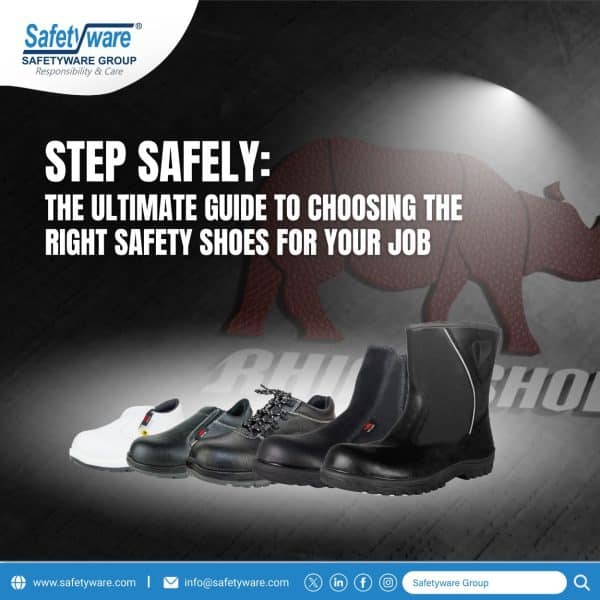Safety Knowledge
Step Safely: The Ultimate Guide to Choosing the Right Safety Shoes for Your Job
Safety shoes are a crucial component of personal protective equipment (PPE) designed to protect workers’ feet from various workplace hazards, such as impact, compression, punctures, and slips. Selecting the right safety shoes for your job is essential to ensure comfort, protection, and compliance with safety regulations. In this comprehensive guide, we will explore key factors to consider when choosing safety shoes, different types of safety features available, and tips to help you find the perfect pair for your specific job requirements.
Understanding the Importance of Safety Shoes:
Safety shoes are designed to provide protection and support for workers in environments where foot injuries are a common risk. Whether you work in construction, manufacturing, warehousing, or any other industry with potential foot hazards, wearing the appropriate safety shoes can prevent injuries, reduce accidents, and promote a safe work environment. By selecting the right safety shoes based on your job tasks and workplace conditions, you can enhance your safety and well-being while on the job.
Factors to Consider When Choosing Safety Shoes:
- Job Requirements: Assess the specific hazards present in your workplace, such as heavy objects, sharp materials, slippery surfaces, or electrical risks. Choose safety shoes that offer adequate protection against these hazards based on your job tasks and work environment.
- Safety Standards: Ensure that the safety shoes you select comply with relevant safety standards, such as EN ISO 20345 or CE: S1P SRA . Look for shoes with appropriate safety ratings to meet the requirements of your job.
- Comfort and Fit: Consider the comfort and fit of the safety shoes, as you may be wearing them for extended periods during your workday. Look for shoes with cushioning, arch support, and a proper fit to prevent discomfort, fatigue, and foot injuries.
- Material and Durability: Choose safety shoes made from high-quality materials that are durable, water-resistant, and suitable for your work environment. Leather, synthetic materials, and composite toe caps are common options that provide protection and longevity.
- Type of Toe Protection: Decide whether you need safety shoes with steel toe caps, composite toe caps, or alloy toe caps based on the level of protection required for your job tasks. Steel toe caps offer maximum impact resistance, while composite toe caps are lightweight and non-metallic.
- Slip Resistance: Look for safety shoes with slip-resistant outsoles to prevent slips, trips, and falls on wet or slippery surfaces. Features like deep treads, oil-resistant soles, and anti-slip technology can enhance traction and stability.
- Electrical Hazard Protection: If you work in an environment with electrical hazards, choose safety shoes with electrical hazard (EH) protection to reduce the risk of electric shock. EH-rated shoes provide insulation against electrical currents and enhance safety in electrified work areas.
- Breathability and Moisture Wicking: Consider safety shoes with breathable materials and moisture-wicking properties to keep your feet dry, comfortable, and odor-free throughout the workday. Proper ventilation and moisture management can prevent foot issues and enhance overall comfort.
Tips for Choosing the Right Safety Shoes:
- Consult with Safety Professionals: Seek guidance from safety professionals or footwear experts to determine the most suitable safety shoes for your job requirements and workplace hazards.
- Try Before You Buy: Visit a store to try on different styles and sizes of safety shoes to find the best fit and comfort level. Walk around, bend your feet, and test the shoes to ensure they meet your needs.
- Consider Customization: If you have specific foot conditions or requirements, consider customizing your safety shoes with orthotic insoles, extra padding, or other modifications to enhance comfort and support.
- Regular Maintenance: Maintain your safety shoes by cleaning them regularly, inspecting for damage, and replacing worn-out parts to ensure continued protection and longevity.
Choosing the right safety shoes for your job is a critical decision that can impact your safety, comfort, and performance at work. By considering factors such as job requirements, safety standards, comfort, material durability, toe protection, slip resistance, electrical hazard protection, breathability, and moisture wicking, you can select safety shoes that offer optimal protection and support for your specific workplace needs. Prioritizing safety and comfort by investing in high-quality safety shoes tailored to your job tasks can enhance your overall well-being and contribute to a safer work environment. Step safely into your workday with the perfect pair of safety shoes that meet your requirements and keep you protected on the job.
Explore more about Foot Protection

